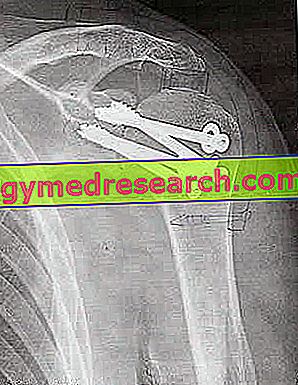Introduction
Summer has arrived, women and ladies of all ages cannot escape the fateful question, the thought that torments us from the spring, that sword of Damocles that we have been feeling for months on our heads ... Ready for the swimsuit test?

On TV, more and more tissue papers, coupons, various succinct and winking magazines ... the ideals proposed by the media, often unreachable, make us impose prohibitive goals whose failure leads to the risk of developing feelings of dissatisfaction and inadequacy.
My ladies, we are in good company, now the Italic male, buying the newspaper at the newsstand, cannot help but come across magazines for men, in the same way as the female ones, where there are titles: Abdominals sculpted, Belly finally flat, Bicep perfect effortlessly ... The models imposed by the mass media present very oiled and very tight barrels.
How to survive all this?
With an eye to our psychophysical well-being, which translates into being well with ourselves, accepting qualities and defects, with an indulgent and benevolent look at the image that the mirror sends us!
Nutrition and Testing Costume
Feeding properly is certainly beneficial, it means staying healthy and ensuring that our body receives what it needs without anything more or less. The advantage of a good and healthy diet will therefore be visible even at the time of the dreaded costume test.
Well, therefore, regulating our diet, the World Health Organization and the Food and Agriculture Organization of the United Nations (FAO) have drawn up the "Guidelines" for a healthy diet. The recommendations can be summarized in a few rules:
- Consume at least five daily portions of fruit and vegetables;
- Increase the intake of high fiber foods;
- Reduce the consumption of saturated fats (for example butter, lard, lard) and refined products (for example biscuits, white sugar);
- Increase consumption of unsaturated fats (fish).
In short: few saturated fats, few sugars and little salt; fruit, vegetables and fish at will, without forgetting the importance, as much as possible, of moderate physical activity: just walk for an hour almost every day.
It is correct to do moderate and constant physical activity, since it produces a stabilization of the immune system and increases self-awareness, decreases anxiety and brings greater mental well-being, for the release of endorphins. Moderate sporting activity increases exertion and strengthens resistance to stress.
Pathological implications
When Bikini Syndrome becomes a disease
In principle, a sort of "concern" in view of the costume test can be considered almost normal, especially if in the winter months we were not particularly attentive to nutrition and sporting activity. For this reason, it is necessary to adopt a healthy lifestyle - characterized by a balanced diet and constant physical activity - throughout the year and not only in view of the costume test, in order to feel at ease in our body and in our forms and in order to avoid the appearance of the so-called "bikini syndrome".
In reality, unfortunately, belonging to Western culture means the often unconscious and uncritical adoption of the models proposed by mass communication, which has long taken over the themes concerning body image and beauty, helping to create and spread stereotypes about the body and image.
We are continually bombarded with deceptive messages that exaggerate the importance of every minimum physical imperfection and propagate symbols of "ideal" beauty, associated with inviting recalls such as wealth, power and happiness.
So for someone chasing an ideal shape and the fear of gaining weight becomes one of the main concerns around which all existence revolves.
Behind the race to the perfect shape, behind the battle at the kilo of too much, sometimes dysmorphophobia can lurk.
Dysmorphophobia (from the Greek dis - morphé, distorted form and φόβος, phobos = fear) is the phobia that arises from a distorted vision that has its own external appearance, caused by an excessive preoccupation with one's own exteriority.
The body is no longer perceived as a whole, but focuses too much on the external appearance or only on a portion of the body. Very often these portions concern women 's breasts, hair, thighs and hips; penis, testicles, hair for men.
Suffering from this disorder (considered a real mental illness) means not appreciating and being afraid of being ugly. It means being so obsessed with your appearance that you see it full of flaws. Which, in reality, do not exist. Or at least not at these levels.
But beware, all women know their strengths and weaknesses, and adopt little tricks to mask their imperfections. Dysmorphophobia is another thing. It is a phobia, indeed. It causes a strong emotional stress, an inability to weave social relations with consequent social isolation. It develops in subjects with low self-esteem, both male and female.
Thus begins the battle: aesthetic care, sacrifice and solitude. Those who suffer from dysmorphophobia are completely focused on their body: they close themselves to the world, go on a diet. Get into eating disorders. If you can afford it, use the scalpel. Seeing an improvement only gives temporary relief. Then, the battle continues: the result is never enough, and other imperfections are highlighted.
Evolution: we end up hating ourselves, feeling so inadequate that we can no longer have relationships with others.
There is also a male face of dysmorphophobia. It is the disorder of muscular dysmorphism. Sufferers always see themselves too thin and all their efforts are aimed at making the muscles grow. Also with wrong diets, anabolic intake and manic exercise.
How can dysmorphobia be combated?
This battle for a better, perfect body can be stopped by starting to wonder where its inability to accept itself comes from. What is essential in these cases is to acquire a sense of self-confidence, such as to allow us the possibility of relating harmoniously with others, without being afflicted by inferiority complexes linked to physical appearance.
Through the acceptance of one's own body, self-knowledge and self-acceptance are developed, which are decisive for a full and positive maturity, which allows us to be open to relationship and contact with others.
However - being a real pathology - the treatment of dysmorphophobia requires the intervention of the doctor and the implementation of a psychological-cognitive behavioral therapy, which can be accompanied by a possible pharmacological treatment if the doctor deems it necessary.
For more information, read: Dysmorphophobia



